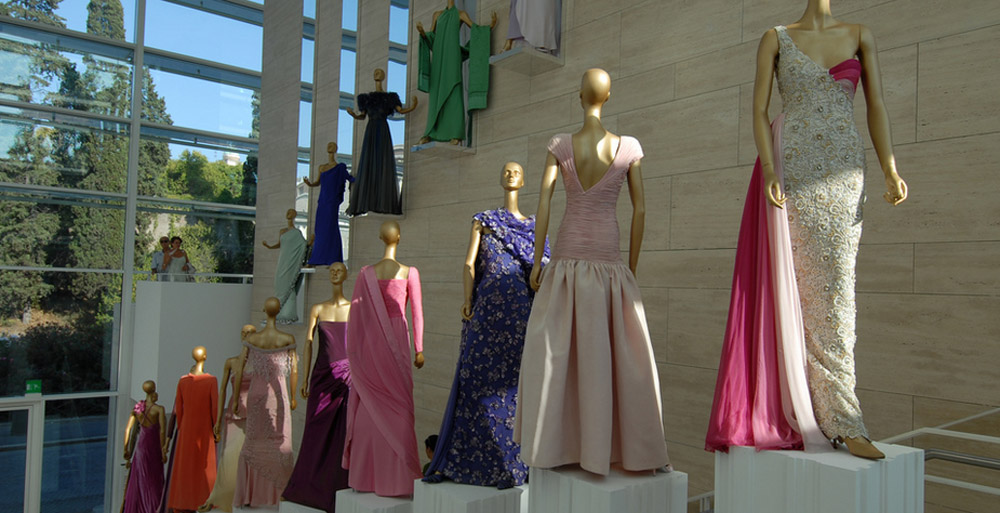Over the past several years, I’ve been advising readers to donate unwanted vintage furs to museums. But how do you donate vintage clothing to museums? It’s time to look at what it really takes to have a vintage garment accepted by a museum.
When I was volunteering at Whanganui Regional Museum, I had a word with the chief acquisitions curator, Trish Nugent-Lyne. She gave me some excellent guidelines about what museums want for their collections – and what you’d be better off taking to the vintage clothing store or the thrift shop.
First, it’s important to note what museums don’t want.
- Museums are often glutted with traditional antique garments, especially bridal gowns and baby items. One regional museum has over 100 antique infant dresses.
- Museums are picky about furs, especially shoulder stoles from the 1930s through the 1960s. There’s a glut of those “brown furs”, as they’re called!

Jaguar fur coat from the 1970s at the Metropolitan Museum of Art, New York. Because it is made from big cat fur, this coat could not be sold today.
Now, that doesn’t mean that you shouldn’t donate a bridal gown or a fur to a museum. But it helps if it has some of the other qualties that make it valuable to museums. Museums are interested in:
- Items that have a history. The more history documentation there is for the garment, the better – receipts, boxes, photographs of the garment being worn, letters mentioning the garment, etc. If you wanted to donate your grandmother’s fur, you could write up this history yourself, and include photographs of her wearing the fur in her younger days.
- Vintage classics. The things that make a vintage item saleable also make it easy to donate:Â excellent condition, vivid color, attractive detailing, very “typical of the time” look and cut, a designer label. Best of all, size doesn’t matter – a divine extra-extra small vintage dress that might not sell as vintage resale is perfect for a museum collection.
- Local/regional designers. These are both fashion history and area history, and therefore valuable to museums.
- Contemporary clothing. Such as blue jeans, popular sneakers, and recent designer clothing. Clothes from the 1970s – 1990s are lacking in many collections.
- Vintage everyday garments. Clothing that was worn to work or for everyday tasks is in short supply, because it was often worn until it was thrown away. Some museums have specialist collections for this. The American Textile Museum keeps an eye out for the printed cottons that were integral to 20th century rural wardrobes in the USA.
- Don’t overlook shoes, hats, undergarments, and costume jewelry. Again, size doesn’t matter! A full ensemble outfit is also excellent.
Items are not accepted by museums automatically. They go through an “accessioning process” where their historical or design value is considered. NEVER just show up at a museum with your items, expecting to leave them there! You must contact the curators in advance and ask if they can consider your donated items. Museum curators are very busy and it can take them a while to consider your donation, so please be patient. Here is an example of the donation process from the Fashion Institute of Technology, and they note:
Items are accepted or rejected on the basis of historical and artistic significance, as well as condition and the strength or weakness in that area of our collections. The Collections Committee meets twice a year to consider donations. A preliminary, pre-selection process is conducted more frequently throughout the year. You will be notified via email or phone if your donation is accepted for Collections Committee review. At that time, the donation should be available for viewing.
Whew. It’s a process, all right.
But for the donator, it’s not so onerous. Really, it’s just three steps. To prepare items for donation:
- Write up a list of what you have, and, if possible, take pictures. If you have a desirable item that is stained or slightly damaged – leave the damage alone for the moment. Textile curators will know what to do if the item is accepted.
- Check the museum’s web site and see if their policy is encouraging about accepting clothing/costume items. Then, email them a description of your items. You can give them a call in two weeks to follow up, but leave it at that.
- When it’s time to go to the museum, pack the items up in a non-cardboard box or set of non-paper bags and go in for the discussion!
After preliminary discussions, I brought a set of items to Whanganui Regional Museum in a laundry basket – I had quite a few items, including an insane 1980s leather jacket. The curators accepted 90% of the items. I helped them complete the paperwork, and then the items were the property of the museum. They had a new home – and I hope that they will be useful, amusing, or interesting to someone.
Image at the top is by photographer Emilio Labrador, reused via Creative Commons.

Pingback: Furs You Can’t Sell: what to do with vintage endangered animal fur clothing | Ever So Scrumptious
Pingback: Selling Grandma’s Vintage Fur | Ever So Scrumptious
Pingback: Fur Guilt » Leigh Feather